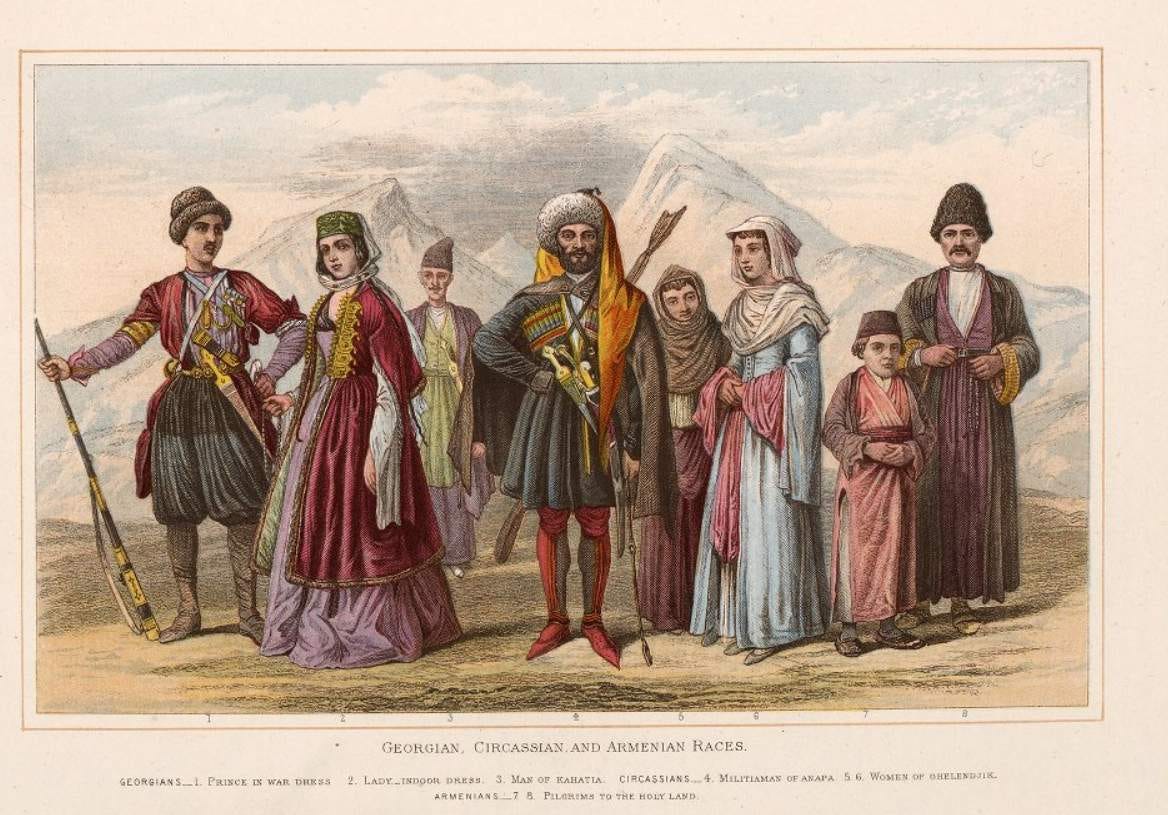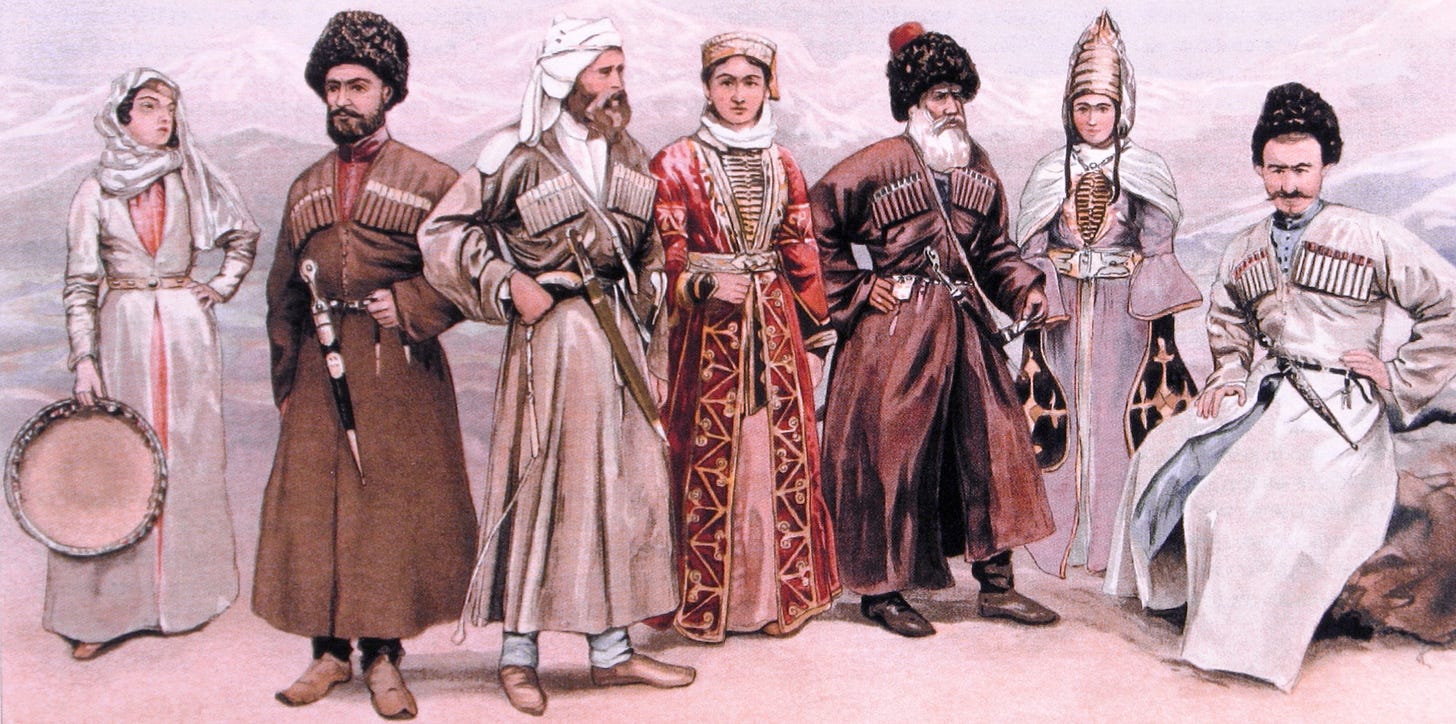Georgian Chauvinism and the Misrepresentation of Caucasian Cultural Heritage
A Historical Examination of Caucasian Traditional Attire.
This short article critically examines the claims presented in the "Gürcü Ansiklopedik Sözlüğü" (Georgian Encyclopedic Dictionary), published in Turkish in 2021, which asserts that traditional Caucasian dress, known as Cherkesska and/or Chokha, is inherently Georgian and spread throughout the Caucasus from Georgia.
The word ‘chugha’ likely has roots in Indo-Aryan languages influenced by Iranian languages, meaning 'outfit made of textile'.
The "Gürcü Ansiklopedik Sözlüğü" (Georgian Encyclopedic Dictionary) published in Turkish in 2021, makes several bold claims about the origins of traditional Caucasian dress. The dictionary, among dozens of similar absurd claims on different topics, states that “The Chokha is a traditional Georgian male costume that has spread throughout the Caucasus from Georgia.” It further asserts that this garment originated with the Georgians and subsequently influenced the entire region. However, a closer examination of historical and archaeological evidence reveals a more complex interplay of cultural influences that shaped the traditional attire of the Caucasus.
The dictionary quotes Prof. Dr. Ronald Topchishvili, who argues that the Chokha spread from the Georgians to the entire Caucasus.
“The Chokha is a national Georgian male costume that has spread throughout the Caucasus. In addition to Georgians, other Caucasian peoples also wear the Chokha. ...Ethnologist Prof. Dr. Ronal Topchishvili explains that the Chokha is often referred to in literature as 'Cherkesska,' creating the misconception that the garment was created by the Circassians and then spread to the Georgians and other Caucasian peoples.”
“It is noted that the first Chokha-like garment among the Circassians, known as Cherkesska, was identified by Peter-Simon Pallas in 1793-1794. It is argued that Circassian clothing from the 15th-18th centuries cannot be considered the prototype of the 19th-century common Caucasian attire. The Russian naming of this garment as Cherkesska has misled people into believing that it originated from the Circassians.”
The Caucasus is known for its extraordinary diversity. This region is home to over 40 ethnic groups, speaks more than 50 languages (ranging from small indigenous families to broader Indo-European, Mongolic, Semitic, and Turkic families), practices various religions (Islam, Christianity, Judaism, Buddhism), and boasts a rich tapestry of geography (mountains, glaciers, lowlands, seashore), history, and culture.
Ethno-linguistic classifications demonstrate the intricate interplay of languages and cultural influences that have shaped the material culture of the Caucasus over centuries.
რომელი ერის მიერაა შექმნილი ჩოხა და საიდან გავრცელდა ჩოხა-ახალუხი საქართველოში (Which nation created the Chokha and from where did the Chokha-Akhalkh spread in Georgia?. Interview with Ronald Topchishvili, Doctor of History, Head of the Institute of Ethnology at Ivane Javakhishvili Tbilisi State University. [Ambebi.ge, 15 February 2018).
See also: Georgians are repeating the claims mentioned here on Reddit ‘Sakartvelo’ page.

Substantial archaeological findings support the deep historical roots of traditional Caucasian clothing. Items of clothing, footwear, and headgear dating back to the 10th-12th centuries reveal a continuity of cultural traditions. For instance, elements of traditional Ossetian clothing found in necropolises provide insights into the material culture that persisted well into the medieval period. Rich archaeological material related to the Alans of the 10th-12th centuries includes elements of male and female costumes that have remained virtually unchanged in traditional Ossetian attire, such as belts, buckles, bracelets, and rings.
Archaeological materials confirm the local origin of the main constructive elements of both male and female costumes in the [North] Caucasus. The development of these clothing styles was NOT solely influenced by any single group but resulted from prolonged cultural interactions among various ethnic communities.
The transformation of traditional Caucasian clothing over time reflects dynamic interactions between local traditions and external influences. Despite changes, elements of traditional mountain attire have been preserved, showcasing the resilience and adaptability of local cultures.
Shortly, the traditional clothing of the Caucasus is the product of centuries of cultural synthesis involving multiple ethnic groups. The archaeological and historical evidence supports a more integrated view, acknowledging the contributions of various Caucasian peoples to the development of their shared material culture. This perspective highlights the rich tapestry of influences that have shaped traditional Caucasian dress, transcending narrow ethno-nationalist narratives.
For further reading on this topic, you can refer to the book Oдежда народов Северного Кавказа. XVIII—XX вв. (Clothing of the Peoples of the North Caucasus. 18th-20th centuries) by Evgeniya N. Studenetskaya, published by Nauka (Science) in Moscow in 1989.







